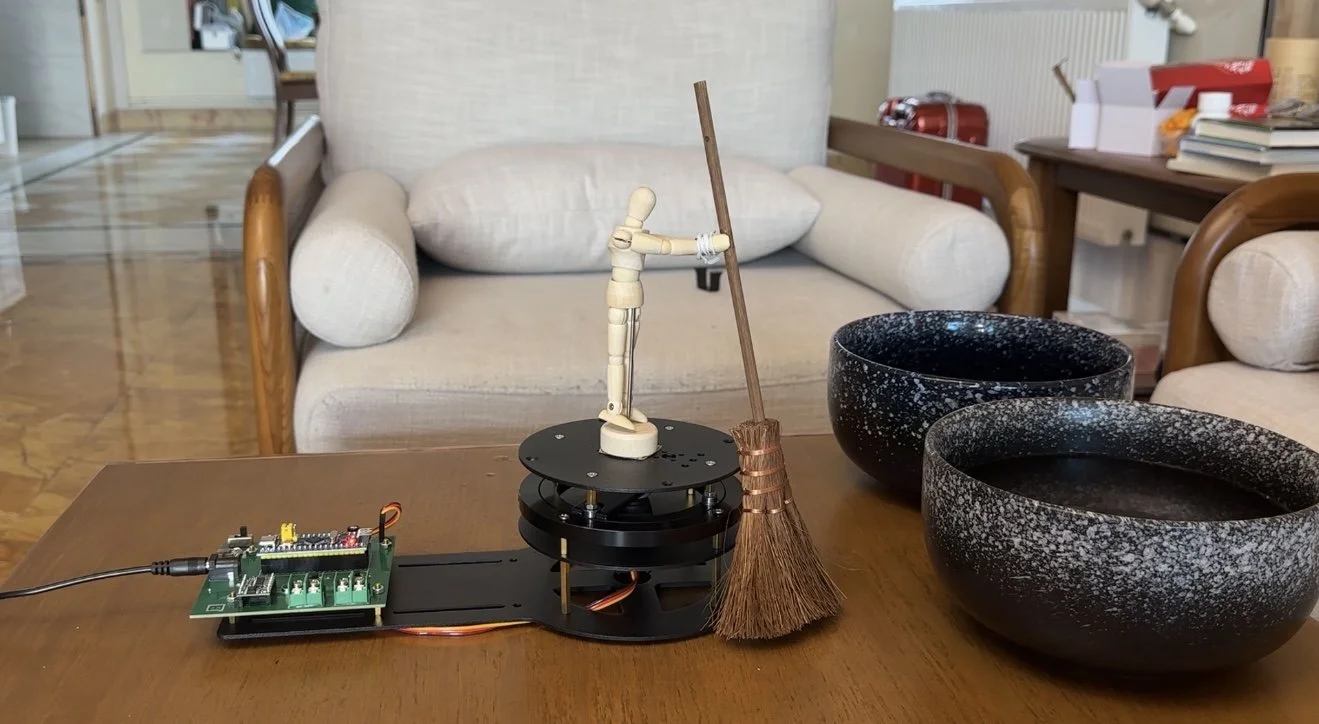
In my interactive installation, There Is No Alternative, I critically examine the ideological entrapment of labor in neoliberal society. Drawing on first-generation critical theory, particularly that of Adorno, Horkheimer, and Marcuse, I designed an embodied experience that confronts the dilemma of endless labor versus passive destruction. Inspired by both social and artistic critique traditions, the work interrogates the illusion of choice under advanced capitalism, inviting the audience not only to participate but to become ethically implicated.
There Is No Alternative
At the center of the installation stands a low-definition mannequin figure performing endless sweeping motions in a closed loop. Audiences control this figure via voice commands—either saying “start” to resume work or “stop” to interrupt it. When stopped, a surrounding pool of water rises slowly, ultimately submerging the figure. This binary interaction system was deliberately chosen to dramatize the structural conditions of neoliberal labor: either persist in ceaseless activity or pause and face annihilation. The system is not liberatory; it restricts action to two fatal outcomes, thereby critiquing the very framework of “freedom” offered by neoliberal subjectivity.
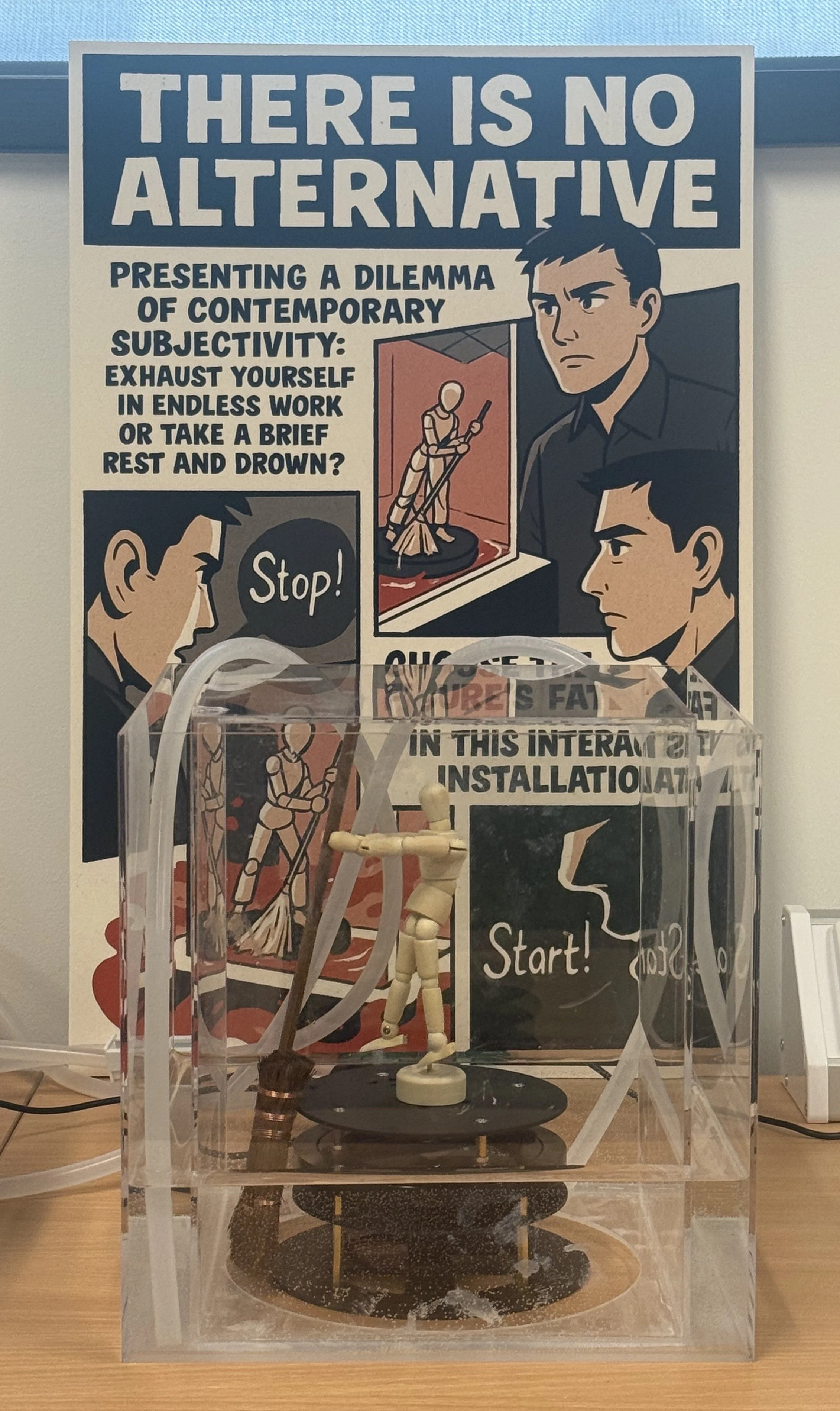

My theoretical grounding was shaped by the Frankfurt School’s notion of the “totally administered society,” wherein technological systems and bureaucratic control suppress authentic human autonomy. I also drew from Byung-Chul Han’s (2012) diagnosis of the “burnout subject” and Franco Berardi’s (2011) reflections on the psychic toll of cognitive capitalism. The work visually and conceptually engages with these critiques through repetition, circularity, and audience interpellation. The servo motor sound, deliberately unmuted, functions as a sonic metaphor for labor’s friction and discomfort—an aural residue of systemized suffering.
In design terms, I used voice interaction rather than buttons to heighten the emotional and ethical tension. Speech is inherently embodied and performative; saying “stop” carries psychological weight, unlike pressing a mechanical button. This aligns with Sara Ahmed’s (2010) theory of “affective economies,” where emotions circulate and accumulate meaning across bodies and systems. The installation thus becomes an affective system in itself, charging the audience’s decisions with emotional residue that lingers.
Voice-controlled interaction is driven by an ESP32 microcontroller, which maps binary audio inputs (“start” and “stop”) to servo and pump actions. The installation’s technical logic mimics the labor-management dichotomy: productivity versus passivity. When the user says “start,” the servo motor activates and the figure sweeps. When “stop” is uttered, the servo halts, and the pump simulates rising water—a slow death. This coding logic was kept intentionally minimal and deterministic to mirror the binary nature of neoliberal choice.
The figure’s low-resolution aesthetic was another intentional choice. Without specific identity markers (such as gender, race, or age), the mannequin invites projection. Viewers can empathize without distraction, imagining the figure as themselves or others. This abstraction, following Scott McCloud’s theories of simplified icons, allows for broader symbolic engagement and aligns with my goal to universalize the condition of exhaustion under neoliberal governance.
Visuals
The figure’s low-resolution aesthetic was another intentional choice. Without specific identity markers (such as gender, race, or age), the mannequin invites projection. Viewers can empathize without distraction, imagining the figure as themselves or others. This abstraction, following Scott McCloud’s theories of simplified icons, allows for broader symbolic engagement and aligns with my goal to universalize the condition of exhaustion under neoliberal governance.


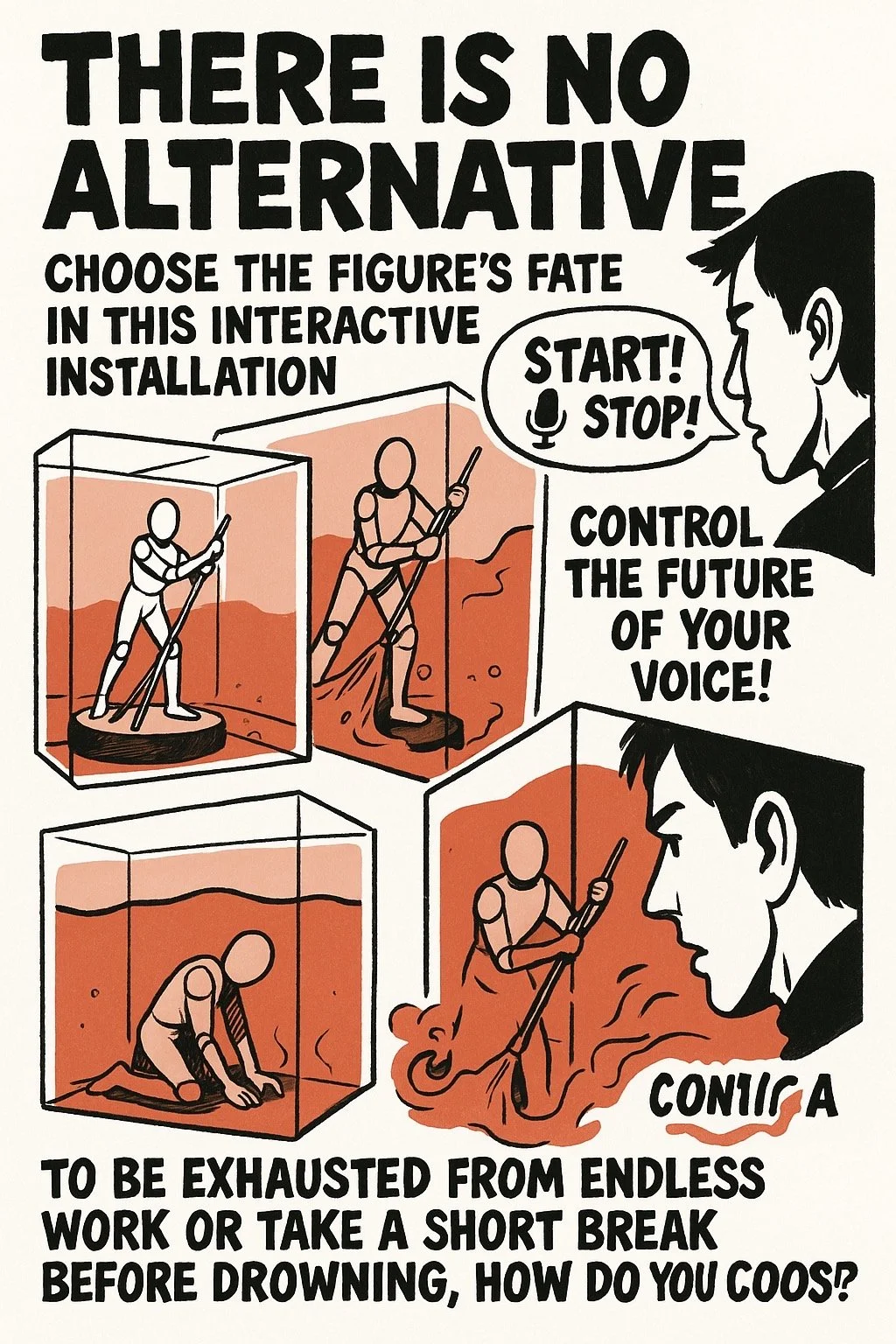
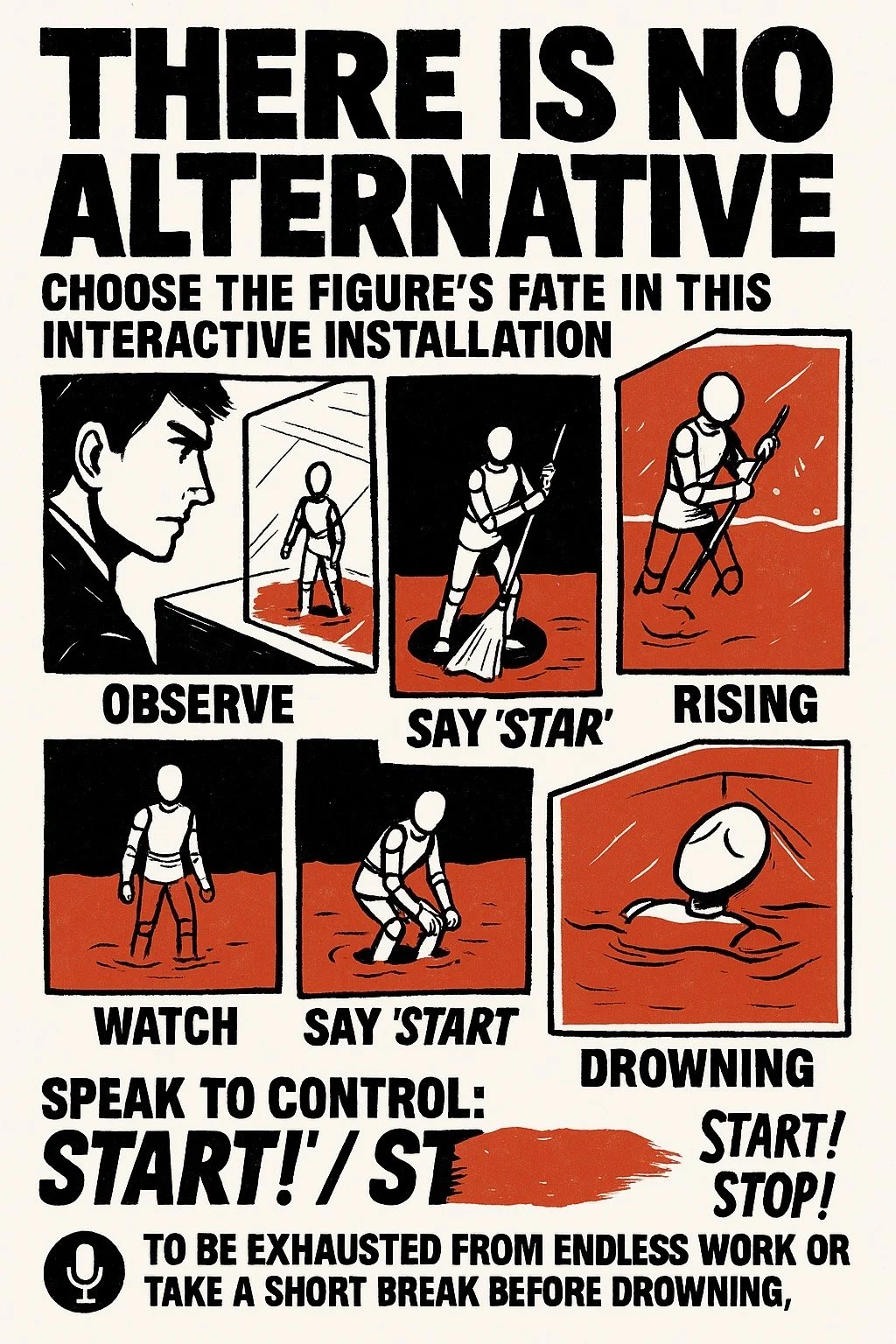

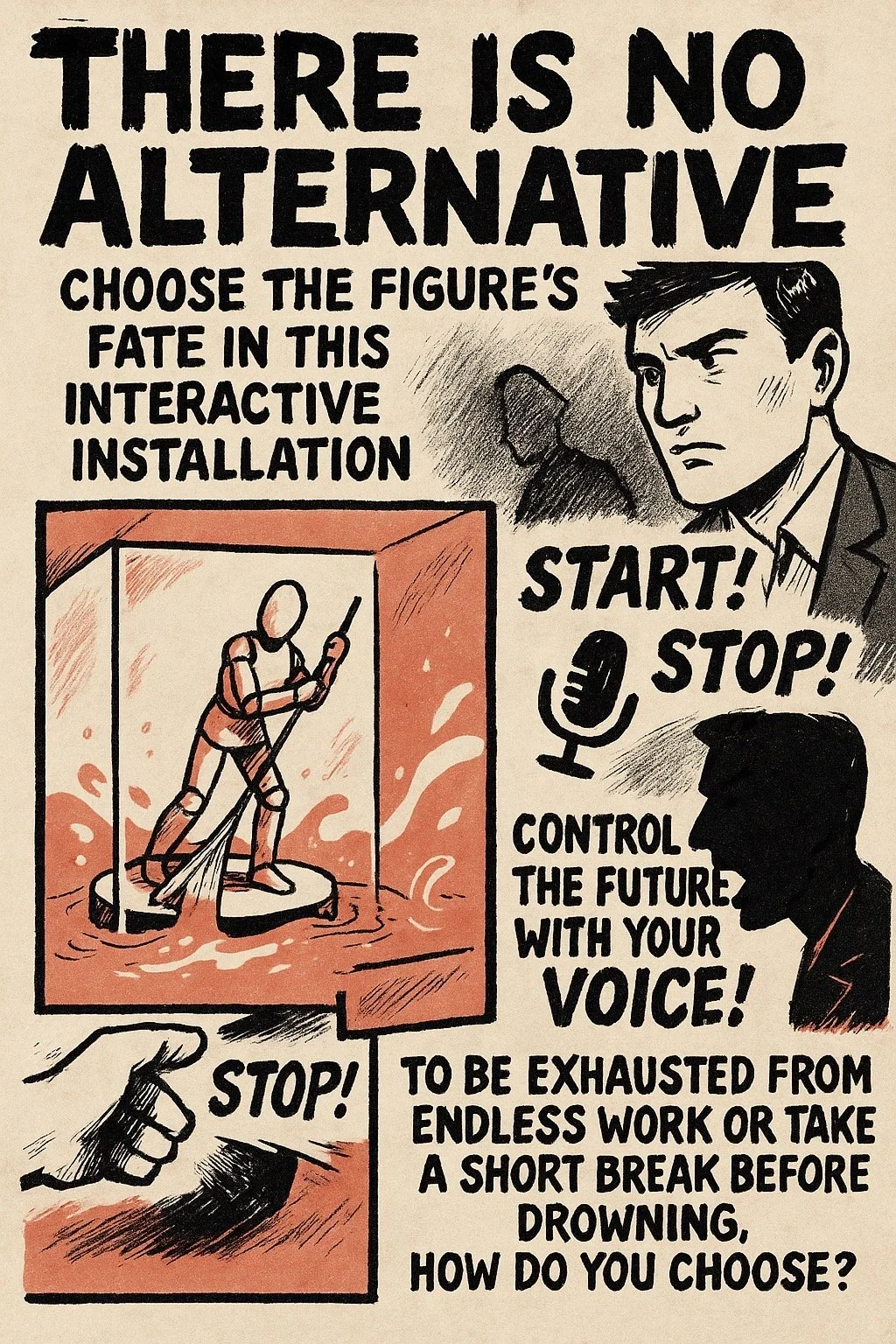
Initially, I planned to use red-dyed water to represent “blood, sweat, and tears,” but this was replaced with clear water due to technical constraints. While the loss reduced some symbolic intensity, it introduced a productive ambiguity. Without overt symbolism, the installation opened itself to multiple interpretations: baptism, drowning, and purification. This shift aligns with relational aesthetics, where meaning emerges through interaction rather than imposition.
A significant design insight emerged during prototyping: the transformation of everyday objects into aesthetic agents. A computer keyboard brush became the figure’s broom, visually amplifying the absurdity of repetitive, futile labor. Likewise, a fish tank pump was repurposed to simulate rising water, transforming a life-sustaining device into a metaphor for existential threat. These substitutions not only solved material constraints but embedded the work in the tradition of arte povera, where the ordinary becomes poetic and political.
In constructing this installation, I also embraced Bruno Latour’s (2008) idea that visualization is critical to knowledge-making. The storyboard served not just as a design tool but as a semiotic bridge between concept, audience, and system. It clarified the installation’s structure, emotional stakes, and moral entanglements. Storyboards and posters circulated with the work, extending its reach beyond the gallery space and inviting ethical reflection even before interaction.
The broader context of this installation is enriched by art historical precedent. As discussed in The Installation Art of Work (2021), installation practices from the 20th century onward have been increasingly employed to critique the evolving nature of labor, from the alienation of industrial production to the performativity of cognitive work. My project aligns with this lineage, particularly in how it uses repetition, immersion, and bodily engagement to reflect the conditions of work rather than simply represent them.
Ultimately, There Is No Alternative resists resolution. The audience is forced into complicity. Their decision to speak or remain silent shapes the fate of a suffering figure. But neither option offers redemption. In this way, the installation mirrors the structure of neoliberal labor regimes: presenting choice while foreclosing alternatives. My work aims to materialize this contradiction, forcing the audience to experience the discomfort of ethical paralysis in a world governed by market logic.
This project sits at the intersection of discursive design, interactive media, and critical theory. It challenges the assumptions of participatory art, revealing how interactivity can reproduce systems of control rather than subvert them. It positions the audience not as saviors but as agents within a machine of consequence. Through visual ambiguity, mechanical discomfort, and affective entanglement, I offer a space where labor is not just represented but felt—seen not only through action, but through inaction.
In conclusion, There Is No Alternative critiques do not work per se, but the conditions under which work becomes inescapable. By dramatizing the false binaries of neoliberal subjectivity, the piece offers no solutions—only confrontation. It asks the audience to dwell in ambiguity, to bear witness, and perhaps, to imagine what an alternative might look like.
